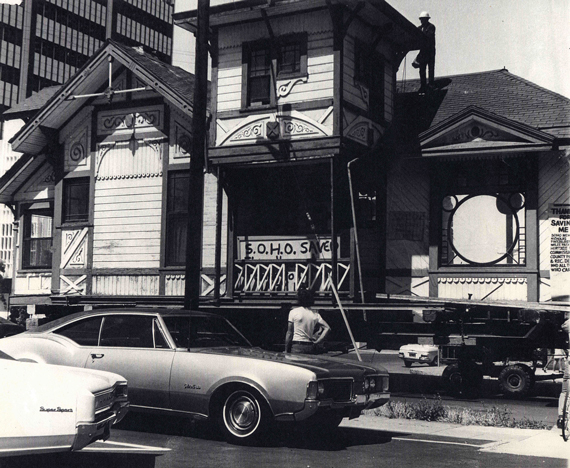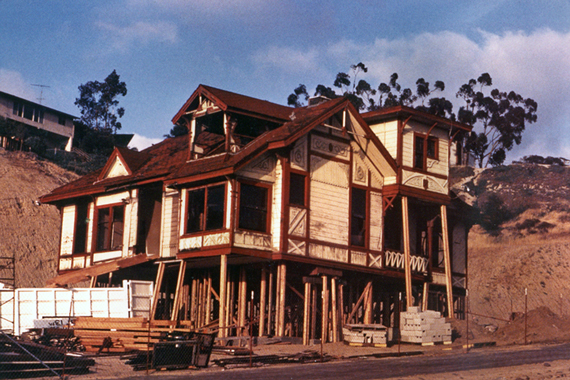|
Nick Fintzelberg, Founding Member Helped Name SOHO
By Ann Jarmusch
May/June 2019
 The Sherman-Gilbert House during the move, with infamous S.O.H.O. Saved hanging on the rail. |
 Waiting in place at the new Victorian reserve for the final move. Photos courtesy SOHO Collection |
Nick Fintzelberg was recruited to join SOHO and help save a Victorian house by his lifelong friend, Carol Lindemulder, before the group even had a name.
In fact, he clinched the final "O" in SOHO at the third meeting in 1969. "We had Save Our Heritage Club as a possible name," Nick said during a recent phone interview. "I came up with Organisation," spelled the English way because the group's initial focus was on preserving only Victorian architecture, specifically the 1887 Sherman-Gilbert House.
Nick recalled this pivotal meeting with a jolt of excitement, clearly remembering the scene 50 years later.
So that's why the 's' in Organisation.
"The others at the meeting were mostly artists. We had some wonderful food gatherings!" Nick volunteered, thereby establishing the origins of SOHO's long tradition of lively parties with lavish refreshments. He will turn 85 on the Fourth of July.
Because he had worked at his father's business for 18 months after earning his Ph.D. in anthropology, Nick brought financial experience to SOHO. This was a rare skill among the early members, including the co-founders, Carol Lindemulder and Robert Miles Parker, by their own admission.
At first, "we were dealing in quarters and half-dollars," Nick said. His financial expertise, generosity, and clear vision for SOHO proved to be crucial in saving the Sherman-Gilbert House.
When he was elected chairman of the board in September 1970, Nick stated three goals, according to Kathleen Flanigan's history of SOHO's first 20 years: "1) the removal of the Sherman-Gilbert House to the 'Victorian Preserve;' 2) support for the proposed legislation that would give the Historical Site Board, which designated historic sites in the City of San Diego, the authority to place 100-day demolition moratoriums on historic structures; and 3) the desire that SOHO become a non-profit organization for tax reasons and to enhance its eligibility for federal grants."
Nick helped SOHO negotiate with the house's owner, the County of San Diego Board of Supervisors and the City Council to buy and move the Sherman-Gilbert House to a planned "Victorian Preserve."
SOHO bought the house for $500, but moving it would be much more expensive ($11,000) and relocation had to wait until the County bought 7.8 acres in Old Town San Diego, which it did in 1971. Heritage Park was born.
"We were so pleased that we were going to get enough land for a dozen houses," Nick recalled. In his view, "The Sherman-Gilbert House is still the most important historic building there, though not the most dramatic one."
Soon after this exciting development, SOHO was informed that the house was to be demolished after all, for a new hospital parking lot. SOHO had raised $6,000 and appealed to County Board of Supervisors for moving money. The members were granted an emergency $5,000 loan. At a public meeting, Nick offered to guarantee the loan with his own funds.
"I pledged $5,000. I was working as the curator at the Museum of Man, and my annual salary was $7,200, so I felt confident I was good for that amount."
"Moving the house was a big, big deal," Nick said, recalling the electrical wires that had to be raised and Juan Street's steep hill. "We took lots of pictures, and we all felt very proud."
Transported in two parts, the three-story Victorian masterpiece remained on the moving platform until it could be permanently sited in the park. The house had been vandalized in the past and was highly vulnerable while empty; arson was another fear as grand Victorians in Los Angeles were being torched. So Nick asked his Mesa College night students in anthropology if anyone wanted to live in the house "for a year or two."
He got several volunteers. Nick remembered that one of his students lived there for over a year "with just enough electricity to power a black-and-white TV and a few lights. The city looked the other way when he tapped into a power line."
Kathleen Flanigan quoted Chairman Fintzelberg after the move: "Now we have the responsibility of maintaining the house until the County takes over at Heritage Park. We won't attempt permanent restoration for about 18 months because the house will have to be moved one more time." She added, "The final site for the redwood Victorian building was only a few yards from its temporary location."
Nick is modest about the rapport he struck with all the City and County officials that SOHO needed on its side to save and move the house. He had an advantage: He is a direct descendant of José María Estudillo, a Spaniard who served as commandant of the Presidio and became one of Old Town's most prominent residents. He started building the adobe Casa de Estudillo in 1827.
"San Diego was a very small, closed city" in earlier decades, Nick said. "Descendants of old families were respected and wielded power. I was lucky."
He relishes the fact that both he and his father, Milton Fintzelberg, worked on preserving Old Town San Diego at the same time, but in different ways. His father helped create Old Town San Diego State Historic Park.
As Nick later discovered, father and son were also connected by the Sherman-Gilbert House. After it was restored, SOHO hosted many events there. "I invited my father, who couldn't walk very well by that time, so I parked close by. Still, he wouldn't come inside."
Driving home, a perplexed Nick asked his father why he had declined to enter the house. That's when Milton shared a secret. When he was 10 or 11 years old, playing with other boys, one of their balls shattered "a beautiful round window" in the Sherman-Gilbert House. Whether he was the culprit or not, Milton took the blame for the accident. Miss Gilbert told his father she wanted an apology from Milton and for him to replace the window. After she accepted the boy's apology, she said, "I don't want you in this house ever again." Long after the Gilbert sisters had died and the house had taken on new life, Milton kept his word.
Fifty years after helping SOHO take off, Nick still favors Victorian houses, although he also admires "California Spanish homes, from 1925 to 1932." He drives his classic 1985 Chrysler woody convertible with SOHO on the license plate. And he and Carol Lindemulder are still good friends.
"I wish SOHO good luck and I'm delighted the group is still with us," Nick said. "I hope more people will join and learn about how wonderful old houses can be."
Editor's note: In commemoration of SOHO's 50th anniversary in 2019, we are reaching out to early members and interviewing as many of them as possible. If you would like to be part of this important project, or know someone who might qualify and be available, please call (619) 297-9327 or email editor@SOHOsandiego.org. We look forward to hearing from you!
In case you missed the first two interviews in this series, here are the links:
Carol Lindemulder Recalls SOHO's Unforgettable Start
John Henderson, Preservation Architect, Helped Build SOHO
Read "History of SOHO - The First 20 Years" by Kathleen Flanigan
View "Four Decades of Historic Preservation in San Diego County," SOHO marked its 40th anniversary with the release of a compelling documentary film by Dan Soderberg chronicling its influential history from 1969 through 2009.
|
2025
2024
2023
2022
2021
2020
2019
2018
2017
2016
2015
|





